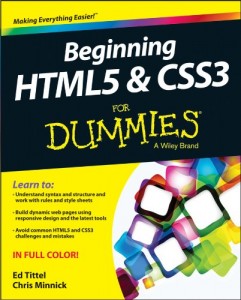My latest book, which I co-authored with Ed Tittel, is out now and available everywhere computer books are sold! If you have no previous experience with web development and you’re interested in learning to create websites, or if you’re already a web developer and want to brush up on the latest HTML and CSS technologies, this is the book for you!
Here’s the link:
Beginning HTML5 and CSS3 For Dummies
In just about 400 full-color pages, you’ll learn all of the essential skills you need to create websites, including:
- How to create the structure of a web page with HTML
- How to use images and multimedia in your web pages
- How to create links in web pages
- How to use CSS to make your pages look great
- How to use typography on the web
- How to use CSS3’s new properties to do advanced text and shadow effects
- How to optimize your web pages for mobile devices
- and much much more!
Plus, there are full-color pictures of our cats, Sparky and Mr. Jones, for those of you who might be more interested in pictures of the cats than in learning to make web pages. This book really does have something for everyone!


